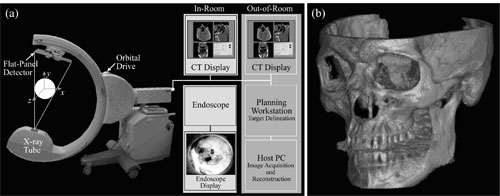Highlighted Papers
V. NEW 3-D IMAGING SYSTEM FOR IMAGE-GUIDED INTERVENTIONS

Figure 1. (a) Illustration of the mobile isocentric C-arm modified to include a flat-panel detector, motorized orbit, geometric calibration, and control system for CBCT acquisition. Intra-operative CBCT reconstructions provided by the host PC are displayed on an in-room display. (b) The example image (skull) illustrates the 3D spatial resolution and FOV.
A new type of cone-beam computed tomography (CBCT) imaging system could enable surgeons and interventional radiologists to perform minimally invasive procedures under the guidance of 3-D images acquired during surgery with sub-millimeter spatial resolution. Medical physicists and engineers from the University Health Network in Toronto and Siemens Medical Solutions will present this technology.
Image-guided interventions have conventionally relied on image data acquired before the procedure on a diagnostic CT or magnetic resonance (MR) scanner. However, reliance on preoperative images does not allow visualization of changes imparted during a surgical procedure, such as seeing what remains of a tumor after it is removed.
This imaging promises to overcome these conventional limitations by providing image updates during the procedure. One new technology showing particular promise is CBCT implemented on a surgical C-shaped arm.
Research at the University of Toronto, headed by Jeffrey Siewerdsen (jsiewerd@uhnres.utoronto.ca), in collaboration with clinical researchers at the University Health Network and at Siemens Medical Solutions (SMS), has yielded a 3-D imaging technology that could provide physicians with sub-millimeter spatial resolution and soft tissue visibility during surgery in near real-time. The technology involves the development of CBCT on a mobile C-arm to acquire a full-volume image in a single rotation around the patient.
While the image quality achieved with early cone-beam CT prototypes is not quite equivalent to that of a high-performance diagnostic CT scanner, image quality has been shown to be sufficient to guide surgeons and radiologists with respect to soft-tissue targets and critical structures.
Patients have been successfully treated with the prototype in a research setting, with trials underway in a broad spectrum of surgical and interventional procedures ranging from tumor ablation to orthopedic surgery and brachytherapy. High-quality intraoperative imaging provided by C-arm CBCT is expected to dramatically improve surgical performance and expand the application of minimally invasive interventions to cases that would be otherwise untreatable. [Wednesday, July 25, 8:55 AM (WE-B-L100F-2), Thursday, July 26, 11 AM (TH-C-M100J-6 ), and 2:54 PM (TH-D-L100J-8)]